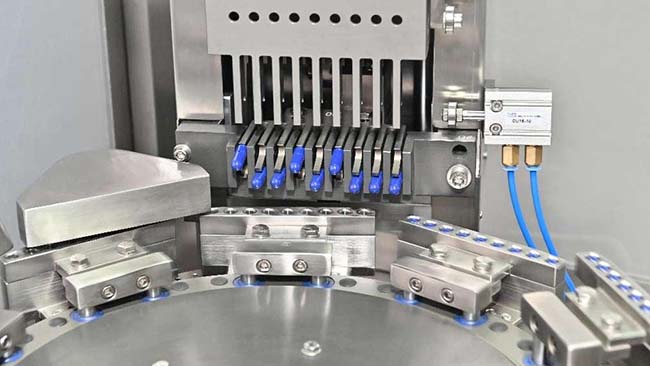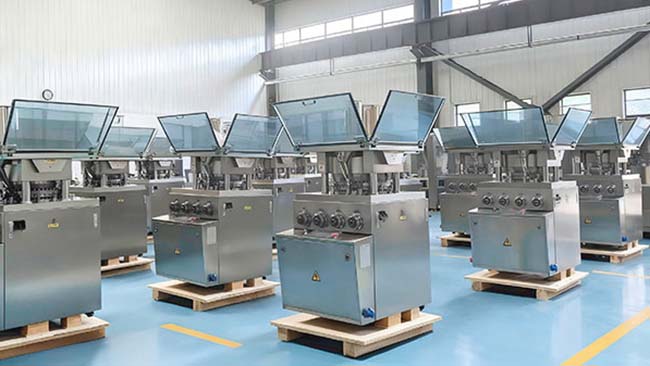Tablettenpresse ist ein unverzichtbares Gerät in der Pharmaindustrie. Es verarbeitet pulverförmige Rohstoffe durch hohen Druck von Matrizen zu festen Tabletten unterschiedlicher Form und Größe. Das Verständnis ihres Funktionsprinzips ist entscheidend für die Herstellung hochwertiger Tabletten, die Optimierung von Produktionsprozessen und einen effizienten Maschinenbetrieb. Dieser Artikel erklärt ausführlich die Funktionsweise einer Tablettenpresse und ihre wichtigsten Komponenten, um Ihnen ein besseres Verständnis des Tablettenpressens zu vermitteln.
1. Was ist das grundlegende Funktionsprinzip einer Tablettenpresse?
Der Funktionsmechanismus der Tablettenpresse lässt sich allgemein als „Formung fester Tabletten durch Druck auf pulverförmiges Material“ beschreiben. Die Rohstoffe werden über das Zuführsystem in eine Matrizenkammer eingebracht, wo zwei Stempel (ein Ober- und ein Unterstempel) das Pulver unter hohem Druck zu festen Tabletten mit vorgegebenen Formen und Größen pressen. Um eine gleichmäßige Qualität jeder Tablette zu gewährleisten, werden Parameter wie Vorpress-/Hauptdruck, Pulverfüllvolumen, Tablettendicke und Revolverdrehzahl kontrolliert, um die Konsistenz und Stabilität während des gesamten Tablettenpressprozesses sicherzustellen und so die Gesamtqualität der Tablettenprodukte zu verbessern.
Zu den wichtigsten Schritten beim Betrieb einer Tablettenpresse gehören:
– Zuführung: Pulverförmiges Rohmaterial wird über den Zuführer gleichmäßig in die Matrizenhöhle befördert.
– Kompression: Die oberen und unteren Stempel üben einen hohen Druck aus, um das Pulver in der Matrizenhöhle zu komprimieren und feste Tabletten zu formen.
– Auswerfen: Die fertigen Tabletten werden durch das Auswerfersystem aus der Matrizenhöhle gedrückt.
Der gesamte Tablettenherstellungsprozess wird kontinuierlich durch einen Rotationsmechanismus durchgeführt, wodurch Rotationstablettenpressen ideal für die Massenproduktion in Pharmaunternehmen sind.
2. Wichtige Komponenten einer Tablettenpresse, die Sie kennen sollten
Wenn Sie die Komponenten einer Tablettenpresse verstehen, können Sie den gesamten Produktionsprozess effektiver gestalten. Hier sind die wichtigsten Teile einer Tablettenpresse:
– Zuführung: Sie stellt sicher, dass das pulverförmige Material gleichmäßig in die Matrize gelangt, was für die Konsistenz der Tablette entscheidend ist.
– Matrizen und Stempel: Die Matrize bestimmt die Form und Größe der Tablette, während die Stempel das Pulver durch Druckausübung zu Tabletten verdichten.
– Antriebssystem: Dieses sorgt für die nötige Leistung zum Pressen der Tablette und besteht normalerweise aus einem Hauptmotor und einem mechanischen Getriebesystem.
– Steuerungssystem: Es erfasst in jedem Schritt des Produktionsprozesses Echtzeitdaten von Sensoren und gewährleistet so eine genaue Kontrolle von Druck, Gewicht und Größe der Tablette.
Jede Komponente spielt eine entscheidende Rolle und ist für die Aufrechterhaltung eines stabilen und zuverlässigen Tablettenproduktionsprozesses unverzichtbar.
3. Verschiedene Arten von Tablettenpressen und ihre Funktionsprinzipien
Je nach Ihren spezifischen Produktionsanforderungen müssen Sie möglicherweise zwischen verschiedenen Arten von Tablettenpressen wählen. Gängige Typen sind:
– Einstationen-Tablettenpresse: Diese Maschine eignet sich für die Kleinserienproduktion oder den Laboreinsatz. Sie ist einfach zu bedienen und produziert jeweils eine Tablette. Ober- und Unterstempel üben in einer geraden Linie Druck aus, um die Tabletten zu formen.
- Rotationstablettenpresse: Dies ist eine hocheffiziente Maschine für die kontinuierliche Großserienproduktion. Ihr Arbeitsprinzip ähnelt dem einer Einstationenpresse, allerdings sind mehrere Stempel auf einem rotierenden Revolver angeordnet. Dadurch werden Pulverfüllung, -kompression und -ausstoß an mehreren Stationen gleichzeitig durchgeführt, was die Produktionseffizienz deutlich steigert.
Aufgrund ihrer hohen Produktivität und Automatisierung ist die Rundlauftablettenpresse ein zentrales Produktionsgerät in vielen großen Pharmafabriken.
4. Wichtige Parameter zur Kontrolle während der Tablettenkompression
Mehrere Parameter beeinflussen die Qualität der Tabletten während des Pressvorgangs direkt. Das Verständnis und die Kontrolle dieser Parameter können Ihnen dabei helfen, Tabletten herzustellen, die den erforderlichen Standards entsprechen.
– Druck: Dieser bestimmt die Härte und Stabilität der Tabletten. Zu hoher Druck kann zum Bruch der Tablette führen, zu geringer Druck kann zu losen Tabletten führen.
– Füllvolumen: Es beeinflusst das Gewicht jeder Tablette und die gleichmäßige Verteilung der Wirkstoffe.
– Geschwindigkeit: Je schneller die Maschine arbeitet, desto höher ist die Tablettenproduktion. Ein hoher Geschwindigkeitsbetrieb kann jedoch zu instabiler Produktqualität und erhöhtem Geräteverschleiß führen. Die Produktionsgeschwindigkeit sollte sorgfältig an die Materialeigenschaften angepasst werden, um Produktqualität und Produktionsleistung in Einklang zu bringen.
Diese Parameter können über das Automatisierungssystem der Maschine eingestellt werden und die Echtzeitüberwachung über Sensoren gewährleistet eine gleichbleibende Tablettenqualität.
5. Unterschiede zwischen kontinuierlichem und intermittierendem Betrieb
Pillenpressen arbeiten typischerweise entweder im kontinuierlichen oder im intermittierenden Modus. Die Wahl zwischen diesen Modi hängt vom Produktionsvolumen und dem gewünschten Automatisierungsgrad ab.
– Kontinuierlicher Modus: Dieser Modus ist ideal für die Produktion im großen Maßstab. Er ermöglicht der Maschine, Tabletten kontinuierlich und ohne Unterbrechung zuzuführen, zu komprimieren und auszuwerfen. Dadurch wird die Effizienz maximiert und manuelle Eingriffe werden minimiert.
– Intermittierender Modus: Geeignet für Kleinserienproduktion oder Laboranwendungen. Die Maschine pausiert nach jedem Presszyklus und ermöglicht manuelle oder automatische Anpassungen vor dem nächsten Zyklus. Dieser Modus ist zwar weniger effizient, bietet aber eine bessere Kontrolle und Überwachung der Qualität jeder Tablette.
Durch Auswahl des geeigneten Betriebsmodus entsprechend Ihren Produktionsanforderungen können Sie sowohl die Effizienz als auch die Tablettenqualität deutlich verbessern.
6. Bedeutung der Pulvermaterialaufbereitung
Die richtige Vorbereitung der Rohstoffe ist vor dem Tablettieren entscheidend. Je nach Materialeigenschaften kann eine Hammermühle erforderlich sein, um große Materialien oder Granulate zu feinem Pulver zu zerkleinern und so die anschließende Granulierung und Verpressung zu erleichtern. Hochwertige pulverförmige Rohstoffe mit guter Fließfähigkeit und Verpressbarkeit können die Qualität und Stabilität der Tablettenpressung deutlich verbessern.
– Hammermühle: Eine Hammermühle nutzt schnell rotierende Hämmer zum Zerkleinern von Materialien und eignet sich zum Zerkleinern harter Materialien. Die Partikelgröße kann durch Wechseln des Siebes angepasst werden, um den unterschiedlichen Anforderungen der Tablettenproduktion gerecht zu werden.
- Trockengranulation und Nassgranulation: Diese beiden Granulationsverfahren sind die wichtigsten Verfahren zur Umwandlung von pulverförmigen Materialien in Granulat. Die Trockengranulation erfordert keine Zugabe von Flüssigkeiten und eignet sich ideal für feuchtigkeitsempfindliche Materialien. Bei der Nassgranulation werden Flüssigkeiten hinzugefügt und gemischt, um Granulat zu bilden. Anschließend wird getrocknet. Sie eignet sich für Materialien mit höherer Klebrigkeit.
In der Praxis haben sowohl die Trocken- als auch die Nassgranulation ihre Vor- und Nachteile. Sie sollten das geeignete Granulationsverfahren basierend auf den Materialeigenschaften und Produktionsanforderungen Ihrer Tabletten auswählen.
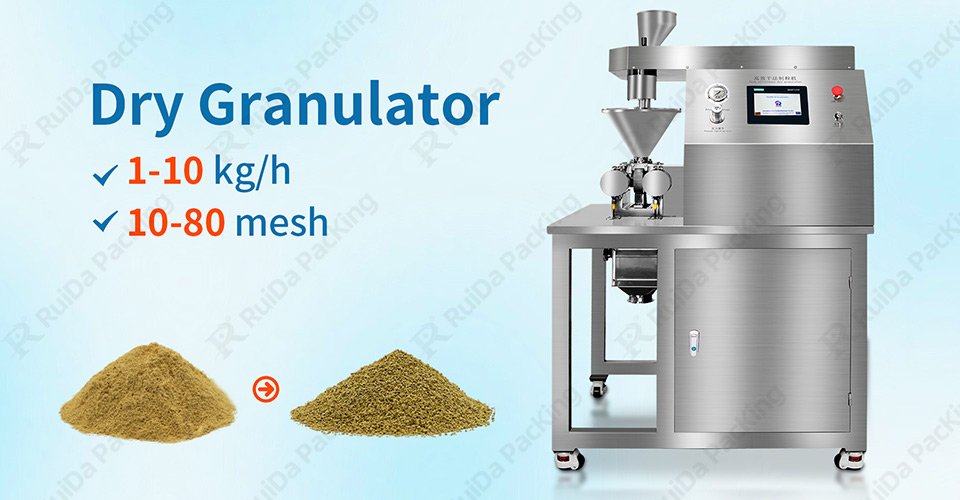
7. Die Beziehung zwischen Formen und Tablettenformen
Die Form ist ein entscheidendes Bauteil, das die Form und Größe der Tablette bestimmt. Bei einer Tablettenpresse besteht die Form aus zwei Stempeln (oben und unten) und einer Matrizenhöhle in der Mitte. Je nach Eigenschaften und Verwendungszweck des Medikaments können Sie zwischen verschiedenen Formen und Größen wählen.
- Tablettenformen: Verschiedene Formen wie rund, oval, dreieckig und andere Sonderformen sind erhältlich. Unterschiedliche Formen beeinflussen nicht nur das Aussehen des Medikaments, sondern auch die einfache Verabreichung für den Patienten.
– Tablettengröße und -gewicht: Durchmesser und Dicke der Tablette werden durch die Größe der Form bestimmt, während die Medikamentendosis und die Materialdichte das Tablettengewicht beeinflussen. Durch die Wahl der richtigen Form können Sie Größe und Gewicht der Tablette steuern und so die Einhaltung pharmazeutischer Vorschriften gewährleisten.
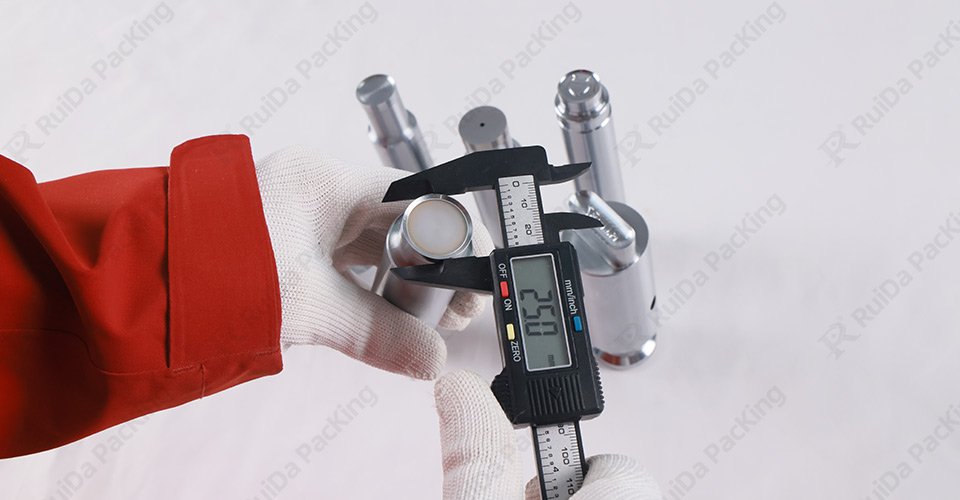
Abschluss
Als Kerngerät der Pharmaindustrie spielt die Tablettenpresse eine entscheidende Rolle für die Qualität der produzierten Tabletten. Das Verständnis der Funktionsweise und Komponenten der Maschine ist entscheidend für die Optimierung der Produktionsprozesse und die Gewährleistung der Konsistenz und hohen Qualität jeder Tablette. Ob Wahl der richtigen Tablettenpresse oder Kontrolle wichtiger Parameter – die Beherrschung dieser technischen Aspekte ermöglicht Ihnen eine effizientere Produktion.
